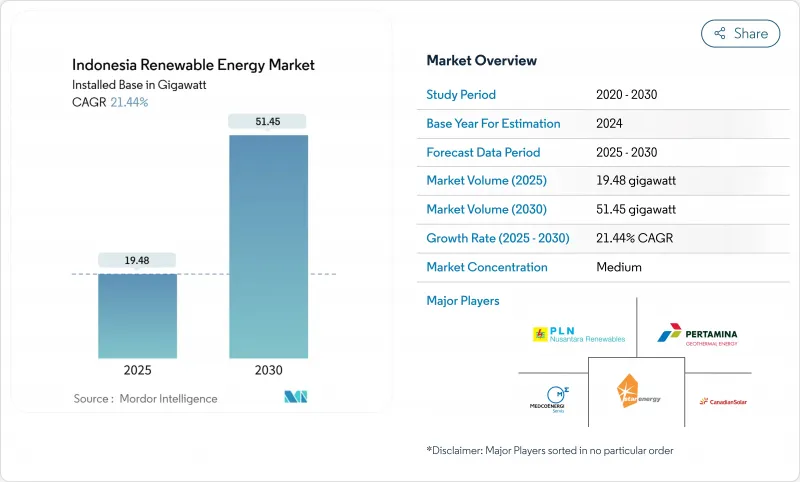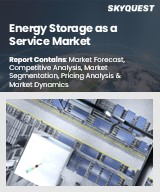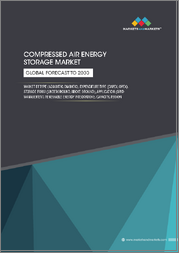
|
시장보고서
상품코드
1851302
인도네시아의 재생에너지 : 시장 점유율 분석, 산업 동향, 통계, 성장 예측(2025-2030년)Indonesia Renewable Energy - Market Share Analysis, Industry Trends & Statistics, Growth Forecasts (2025 - 2030) |
||||||
인도네시아의 재생에너지 시장 규모는 2025년 19.48기가와트에서 2030년에는 51.45기가와트에 달하고 예측 기간 중(2025-2030년) CAGR은 21.44%를 나타낼 것으로 예측됩니다.

강한 정책적 추풍, 기술비용 저하, 기업 수요 증가가 이 기세를 뒷받침하는 한편, 정부는 기후 변화 목표와 경제 성장을 양립시키고 있습니다. 프라보워 스비언트 대통령은 2025년 1월 72조 루피아(44억 달러)에 해당하는 37개의 전력 프로젝트를 출범시켰는데, 이는 송전망 업그레이드와 새로운 발전 용량에 대한 국가의 뒷받침을 강조하는 것이었습니다. 수력 발전은 여전히 발전 믹스를 주도하고 있지만 프로젝트의 경제성이 향상되고 독립 발전 사업자가 레거시 자산 이외의 다양화를 진행함에 따라 태양광 발전이 가장 빠르게 성장하고 있습니다. 200억 달러의 저스트 에너지 전환 파트너십을 포함한 기후 변화 금융의 유입은 자본 제약을 완화하고 있지만, 석탄의 과잉 생산 능력과 PLN의 싱글 바이어 모델은 민간 투자를 계속 감속시키고 있습니다.
인도네시아의 재생에너지 시장 동향과 인사이트
태양광 발전과 풍력 발전의 LCOE 저하
세계 평균 태양광 발전 비용은 2024년 0.044 USD/kWh로, 육상 풍력 발전 비용은 0.033 USD/kWh로 떨어졌으며 석탄 벤치마크인 0.065 USD/kWh 미만으로 떨어졌습니다. 인도네시아에서는 2024년 8월에 국산재 규제가 완화되었기 때문에 사업자는 육상에서의 조립을 유지한 채로, 보다 저렴한 모듈을 수입할 수 있게 되어, 프로젝트의 파이프라인이 가속합니다. 이러한 경제성으로 인해 PLN은 발전 비용 억제에 중점을 두었습니다. 특히 연료비 회피와 탄소 가격 변동 위험으로 인해 신규 건설의 경제성이 자연 에너지에 기울어져 있기 때문입니다. 그 결과 인도네시아의 재생에너지 시장에서는 그린필드의 발전용량을 늘리기 위해 태양광발전과 풍력발전으로 꾸준히 축발이 옮겨가고 있습니다. 현재 진행중인 자금 조달 개혁은 개발자가 한때 직면 한 프리미엄을 축소함으로써이 비용 평가를 더욱 확대하고 있습니다.
RUPTL 2025-2034년 53GW의 신규 재생에너지 용량 파이프라인
인도네시아의 전력 공급 계획은 2034년까지 69.5GW의 신규 발전 용량을 계획하고 있으며, 그 76%는 재생에너지 또는 축전지로 2,967조 루피아(1,825억 달러)의 투자가 필요합니다. 이 파이프라인의 73%는 민간 파트너십에 의해 봉사되었으며 인도네시아의 재생에너지 시장은 보다 깊은 기술의 다양화로 전환될 것으로 예측됩니다. 로드맵은 1710만kW의 태양광 발전, 720만kW의 풍력발전, 520만kW의 지열발전이 예정되어 수력발전의 역사적 우위성을 넘어 보다 유연한 송전망을 가능하게 합니다. 계획된 2기의 25만kW 원자력발전소는 베이스로드의 저탄소 공급을 보다 장기적으로 추구하는 것을 강조하는 것으로, 2040년 재생에너지 41%라는 목표는 투자자에게 보다 명확한 시야를 제공하는 것입니다.
석탄 과잉 용량 및 운전 의무 PPA
레거시 석탄 PPA는 발전소가 최대 절전 상태에서도 PLN에 용량 요금을 지불하도록 의무화하고 있으며, PLN은 연간 80억 달러 이상의 비용 부담을 받고 있습니다. 이러한 마스트 런 조항은 더 저렴한 자연 에너지 조달을 방해하고 유리한 경제성에도 불구하고 단기 증설을 제한합니다. 석탄의 구조적 잠금은 에너지 전환 메커니즘 하에서 조기 상각 계획이 자금을 확보하고 계약을 재협상함으로써 완화되지만, 그 일정은 여전히 불투명하고 인도네시아 재생에너지 시장의 성장을 계속 억제하고 있습니다.
부문 분석
수력발전은 광범위한 하천자산과 성숙한 댐망을 배경으로 2024년 인도네시아 재생에너지 시장 점유율의 50.56%를 유지했습니다. 510MW의 Batang Toru 프로젝트 및 기타 레거시 댐은 기준선 출력을 높게 유지하며 송전망의 신뢰성을 지원합니다. 이와 병행하여 Cirata 145MWac의 부유식 태양광 발전소는 개발자가 저수지를 이용하여 새로운 토지 면적을 확보하지 않고 대규모 PV를 설치하는 방법을 보여줍니다.
태양광 발전은 모듈 가격이 하락하고 옥상 설치 정책이 추진됨에 따라 2030년까지 24%의 성장을 지속하는 확실한 성장 엔진입니다. 부유식 및 지상 설치형 프로젝트가 RUPTL 2025-2034의 목표 1710만kW로 가는 길을 엽니다. 지열은 스타에너지사(Star Energy)의 3억 4,600만 달러를 던진 사라크(Salak)와 와양 윈두(Wayang Windu)에 걸친 10만 2,600만 kW의 증설에 힘입어 틈새면서 바닥 단단한 노선을 유지하고 있습니다. 풍력 발전의 전망은 술라웨시와 동 누사 툰가라의 해안을 따라 개선되고 있지만, 토지 취득의 계쟁이 스케줄의 중하가 되고 있습니다. 이러한 변화를 종합하면 인도네시아의 재생에너지 시장 규모는 급속한 궤도를 유지하면서 수력발전에 집중에서 벗어나고 있습니다.
인도네시아의 재생에너지 시장 보고서는 발전전원(태양에너지, 풍력에너지, 수력에너지, 지열에너지, 바이오에너지), 최종사용자(유틸리티 스케일, 상업 및 산업용, 주택용), 설치 유형(계통 연계 집중형, Off-grid·마이크로그리드, 재생에너지와 스토리지의 하이브리드)로 구분하고 있습니다. 시장 규모와 예측은 설치 용량(GW)으로 제공됩니다.
기타 혜택 :
- 엑셀 형식 시장 예측(ME) 시트
- 3개월간의 애널리스트 지원
목차
제1장 서론
- 조사 전제조건과 시장 정의
- 조사 범위
제2장 조사 방법
제3장 주요 요약
제4장 시장 상황
- 시장 개요
- 재생에너지 믹스
- 시장 성장 촉진요인
- 태양광 발전과 풍력 발전의 LCOE 저하
- RUPTL 2025-2034년의 파이프라인은 53GW의 신규 RE
- JETP와 다자간 기후 변화 자금 유입
- B40/B50 바이오연료 혼합의무화 추진
- 데이터센터와 기업의 PPA 붐
- 라스트 원 마일 전화를위한 오프 그리드 마이크로그리드
- 시장 성장 억제요인
- 석탄의 과잉 생산 능력과 마스트란 PPA
- ASEAN의 동업 타사에 비해 높은 자본 비용
- PLN의 일사 독점은 경쟁을 제한
- 풍력/수력 발전용지에 있어서 토지 취득의 싸움
- 공급망 분석
- 규제 상황
- 기술의 전망
- Porter's Five Forces
- 공급기업의 협상력
- 구매자의 협상력
- 신규 참가업체의 위협
- 대체품의 위협
- 경쟁 기업 간 경쟁 관계
- PESTEL 분석
제5장 시장 규모와 성장 예측
- 원천별
- 태양광
- 풍력
- 수력
- 지열
- 바이오에너지
- 최종 사용자별
- 유틸리티 규모
- 상업 및 산업용
- 주거용
- 설치 유형별
- 계통 연계형 중앙 집중식
- 독립형 마이크로그리드
- 재생에너지 및 저장장치 하이브리드
제6장 경쟁 구도
- 시장 집중도
- 전략적 움직임(M&A, 파트너십, PPA)
- 시장 점유율 분석(주요 기업의 시장 순위/점유율)
- 기업 프로파일
- PLN Renewables(PT Pembangkitan Jawa-Bali, PT Indonesia Power)
- Pertamina Geothermal Energy
- Star Energy Geothermal
- Medco Power Indonesia
- Canadian Solar Inc.
- Trina Solar Ltd
- PT Sumber Energi Sukses Makmur
- PT Barito Renewables Energy Tbk
- SEG Solar
- PT ATW Solar Indonesia
- Fourth Partner Energy Pvt Ltd
- Xurya Daya Indonesia
- TotalEnergies ENEOS
- ACWA Power
- Masdar
- Northstar PLTS
- Bright PLN Batam
- PT Supreme Energy
- PT Geo Dipa Energi
- PT Sarulla Operations
제7장 시장 기회와 향후 전망
KTH 25.11.12The Indonesia Renewable Energy Market size in terms of installed base is expected to grow from 19.48 gigawatt in 2025 to 51.45 gigawatt by 2030, at a CAGR of 21.44% during the forecast period (2025-2030).

Strong policy tailwinds, falling technology costs, and rising corporate demand drive this momentum while the government balances climate goals with economic growth. President Prabowo Subianto's January 2025 inauguration of 37 electricity projects worth IDR 72 trillion (USD 4.4 billion) underscored state backing for grid upgrades and new capacity . Hydropower still leads the generation mix, yet solar PV registers the fastest growth as project economics improve, and independent power producers diversify beyond legacy assets. Climate-finance inflows, including the USD 20 billion Just Energy Transition Partnership, are easing capital constraints, though coal over-capacity and PLN's single-buyer model continue to slow private investment.
Indonesia Renewable Energy Market Trends and Insights
Falling solar & wind LCOE
Global average solar costs fell to USD 0.044/kWh in 2024 and onshore wind to USD 0.033/kWh, undercutting coal's USD 0.065/kWh benchmark . Indonesia's August 2024 relaxation of local-content rules lets developers import cheaper modules while keeping assembly onshore, accelerating project pipelines. These economics sharpen PLN's focus on curbing generation costs, especially as avoided fuel outlays and carbon-pricing risks tilt new-build economics toward renewables. The result is a steady pivot in the Indonesian renewable energy market toward solar and wind for green-field capacity additions. Ongoing financing reforms further magnify this cost parity by narrowing the premium that developers once faced.
RUPTL 2025-34 Pipeline of 53 GW New Renewable Capacity
Indonesia's power-supply plan calls for 69.5 GW of new capacity by 2034, 76% of which is renewable or storage, requiring IDR 2,967 trillion (USD 182.5 billion) in investment . Private partnerships are expected to fund 73% of this pipeline, shifting the Indonesian renewable energy market toward deeper technology diversification. The roadmap earmarks 17.1 GW solar, 7.2 GW wind, and 5.2 GW geothermal, moving beyond hydropower's historic dominance and enabling a more flexible grid. Two planned 250 MW nuclear units underscore a longer-term quest for baseload low-carbon supply, while the 41% renewable target for 2040 offers clearer visibility for investors.
Coal Over-Capacity & Must-Run PPAs
Legacy coal PPAs obligate PLN to pay capacity charges even when plants are idle, costing the utility more than USD 8 billion annually . These must-run clauses crowd out procurement of cheaper renewables, limiting short-term additions despite favorable economics. Coal's structural lock-in is set to ease only as early-retirement schemes under the Energy Transition Mechanism secure funding and renegotiate contracts, but the timetable remains uncertain and continues to temper growth in the Indonesian renewable energy market.
Other drivers and restraints analyzed in the detailed report include:
- JETP & Multilateral Climate-Finance Inflows
- Mandatory B40/B50 Biofuel Blending Push
- High Cost of Capital versus ASEAN Peers
For complete list of drivers and restraints, kindly check the Table Of Contents.
Segment Analysis
Hydropower retained 50.56% of the Indonesian renewable energy market share in 2024 on the back of extensive riverine assets and mature dam networks. The 510 MW Batang Toru project and other legacy dams keep baseline output high, anchoring grid reliability. In parallel, the Cirata 145 MWac floating-solar plant illustrates how developers use reservoirs to install PV at scale without new land footprints.
Solar PV is the undisputed growth engine, compounding 24% through 2030 as module prices fall and rooftop policies gain traction. Floating and ground-mount projects pave the way toward the 17.1 GW target in RUPTL 2025-34. Geothermal retains a niche yet resilient path, buoyed by Star Energy's USD 346 million expansion that will add 102.6 MW across Salak and Wayang Windu. Wind prospects improve along coastal Sulawesi and East Nusa Tenggara, although land-acquisition disputes weigh on timelines. Collectively, these shifts keep the Indonesian renewable energy market size on its rapid trajectory while broadening the mix away from hydropower concentration.
The Indonesia Renewable Energy Market Report is Segmented by Source (Solar, Wind, Hydro, Geothermal, and Bioenergy), End User (Utility-Scale, Commercial and Industrial, and Residential), and Installation Type (Grid-Connected Centralised, Off-Grid Microgrid, and Hybrid RE and Storage). The Market Size and Forecasts are Provided in Terms of Installed Capacity (GW).
List of Companies Covered in this Report:
- PLN Renewables (PT Pembangkitan Jawa-Bali, PT Indonesia Power)
- Pertamina Geothermal Energy
- Star Energy Geothermal
- Medco Power Indonesia
- Canadian Solar Inc.
- Trina Solar Ltd
- PT Sumber Energi Sukses Makmur
- PT Barito Renewables Energy Tbk
- SEG Solar
- PT ATW Solar Indonesia
- Fourth Partner Energy Pvt Ltd
- Xurya Daya Indonesia
- TotalEnergies ENEOS
- ACWA Power
- Masdar
- Northstar PLTS
- Bright PLN Batam
- PT Supreme Energy
- PT Geo Dipa Energi
- PT Sarulla Operations
Additional Benefits:
- The market estimate (ME) sheet in Excel format
- 3 months of analyst support
TABLE OF CONTENTS
1 Introduction
- 1.1 Study Assumptions & Market Definition
- 1.2 Scope of the Study
2 Research Methodology
3 Executive Summary
4 Market Landscape
- 4.1 Market Overview
- 4.2 Renewable Energy Mix
- 4.3 Market Drivers
- 4.3.1 Falling solar & wind LCOE
- 4.3.2 RUPTL 2025-34 pipeline of 53 GW new RE
- 4.3.3 JETP & multilateral climate-finance inflows
- 4.3.4 Mandatory B40/B50 biofuel blending push
- 4.3.5 Data-centre & corporate PPA boom
- 4.3.6 Off-grid microgrids for last-mile electrification
- 4.4 Market Restraints
- 4.4.1 Coal over-capacity & must-run PPAs
- 4.4.2 High cost of capital vs ASEAN peers
- 4.4.3 PLN single-buyer monopoly limits competition
- 4.4.4 Land-acquisition conflicts in wind/hydro sites
- 4.5 Supply-Chain Analysis
- 4.6 Regulatory Landscape
- 4.7 Technological Outlook
- 4.8 Porter's Five Forces
- 4.8.1 Bargaining Power of Suppliers
- 4.8.2 Bargaining Power of Buyers
- 4.8.3 Threat of New Entrants
- 4.8.4 Threat of Substitutes
- 4.8.5 Competitive Rivalry
- 4.9 PESTLE Analysis
5 Market Size & Growth Forecasts
- 5.1 By Source
- 5.1.1 Solar
- 5.1.2 Wind
- 5.1.3 Hydro
- 5.1.4 Geothermal
- 5.1.5 Bioenergy
- 5.2 By End User
- 5.2.1 Utility-Scale
- 5.2.2 Commercial and Industrial
- 5.2.3 Residential
- 5.3 By Installation Type
- 5.3.1 Grid-Connected Centralised
- 5.3.2 Off-Grid Microgrid
- 5.3.3 Hybrid RE and Storage
6 Competitive Landscape
- 6.1 Market Concentration
- 6.2 Strategic Moves (M&A, Partnerships, PPAs)
- 6.3 Market Share Analysis (Market Rank/Share for key companies)
- 6.4 Company Profiles (includes Global level Overview, Market level overview, Core Segments, Financials as available, Strategic Information, Products & Services, and Recent Developments)
- 6.4.1 PLN Renewables (PT Pembangkitan Jawa-Bali, PT Indonesia Power)
- 6.4.2 Pertamina Geothermal Energy
- 6.4.3 Star Energy Geothermal
- 6.4.4 Medco Power Indonesia
- 6.4.5 Canadian Solar Inc.
- 6.4.6 Trina Solar Ltd
- 6.4.7 PT Sumber Energi Sukses Makmur
- 6.4.8 PT Barito Renewables Energy Tbk
- 6.4.9 SEG Solar
- 6.4.10 PT ATW Solar Indonesia
- 6.4.11 Fourth Partner Energy Pvt Ltd
- 6.4.12 Xurya Daya Indonesia
- 6.4.13 TotalEnergies ENEOS
- 6.4.14 ACWA Power
- 6.4.15 Masdar
- 6.4.16 Northstar PLTS
- 6.4.17 Bright PLN Batam
- 6.4.18 PT Supreme Energy
- 6.4.19 PT Geo Dipa Energi
- 6.4.20 PT Sarulla Operations
7 Market Opportunities & Future Outlook
- 7.1 White-space & Unmet-Need Assessment



















